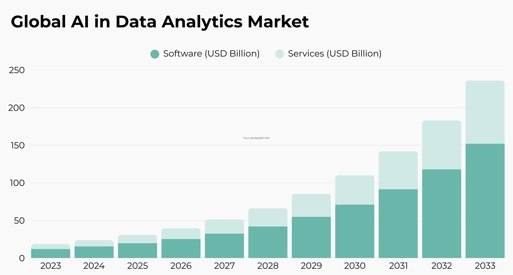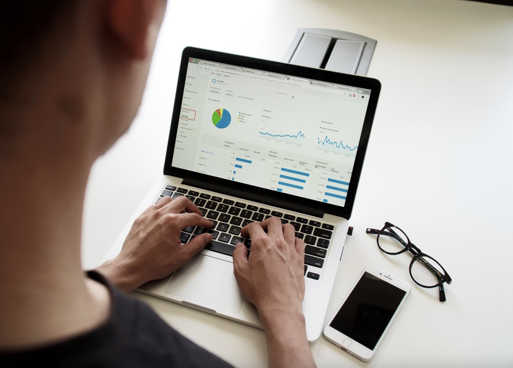What's on this page?
Jump to:
- Why AI Matters in Data Analytics
- What Tasks Does AI Help With in Data Analytics?
- What AI-Powered Tools, Software and Processes Should Data Analysts Know?
- What AI Skills Should You Build to Become a Data Analyst (And Why)?
- The Impact of AI on Data Career Opportunities & Job Roles
- How You Can Prepare for an AI-powered Career in Data: Practical Steps
- Summarising AI's Impact on Data Analytics
- FAQs on The Uses and Impact of AI in Data Analytics
Why AI Matters in Data Analytics
For years, data analytics has been about collecting, cleaning, analysing, and visualising data. Now, AI is raising the game. By adding machine-learning models, automation, and advanced pattern-matching, analytics teams can turn raw data into faster, sharper insight.
For someone looking to launch or switch to a career as a Data Analyst (or move towards more advanced roles), understanding how AI plays into that is a significant differentiator. This isn't about learning a bunch of new tools for the sake of it. You need to learn the skills that actually help companies make better decisions and move faster.
AI is also reshaping the daily responsibilities of data professionals. Routine tasks such as data cleaning, reporting, and trend identification are increasingly automated, freeing up analysts to focus on strategic interpretation and storytelling, a.k.a "the human side" of data. This means employers are seeking professionals who not only know how to use AI-powered tools but who also understand how to guide these systems, question their outputs, and translate results into meaningful business action.
In practice, this shift is creating new opportunities for analysts who embrace continuous learning. Those with a solid grounding in statistics, programming, and domain knowledge, combined with an awareness of how AI models work, are in high demand. By developing these capabilities, you position yourself as a data professional who can bridge the gap between human insight and machine intelligence, driving impact in every sector from finance to healthcare to marketing.
UK organisations scaling AI-powered analytics: 69% cite faster decision-making
In the UK survey State of AI+BI Analytics Global 2025, 69% of respondents said faster decision-making was the main benefit of combining AI and business intelligence.

What Tasks Does AI Help With in Data Analytics?
Let’s break down the kinds of analytics work where AI is making an impact. And what that means for you.
Data preparation and cleaning
Large datasets will often contain errors, duplicates or missing values. AI tools can help automate the detection of anomalies, suggest how to impute missing values, and speed up the process. This means a Data Analyst can spend less time on repetitive work and more time on interpretation and value-adding insight.
Pattern identification & predictive modelling
Beyond descriptive dashboards, AI models can spot patterns humans might miss, forecast trends, cluster behaviours or detect outliers. For example, a business might use an AI model to predict which customers are likely to churn or which product lines may underperform. It’s about being ahead of the game.
Automated reporting and insight generation
AI can generate narrative summary reports, highlight key deviations, or build ‘what-if’ scenarios. This frees the Analyst to challenge assumptions rather than just compile reports.
Embedded analytics & self-service
More organisations are embedding analytics into frontline tools. With AI, a non-technical user might ask a natural-language question (e.g., “show me regional sales trends by product category”) and get a response. As a Data Analyst, your knowledge of how these AI-driven interfaces work is a plus.
Decision-support and real-time analytics
In sectors like finance, marketing, or operations, AI models can run in near real-time, delivering recommendations or flagging risks as they appear. Having the ability to interpret and validate those outputs becomes key for Analysts.
Nonetheless, the implementation of AI is being held back by a lack of skills, as organisations struggle to find professionals who understand both data and AI.

What AI-Powered Tools, Software and Processes Should Data Analysts Know?
When you move into or progress within data analytics, being familiar with certain tools and processes gives you an edge. Here are some of the important ones:
- Machine learning platforms: Tools like scikit-learn, TensorFlow, or PyTorch. You don’t need to build models yourself, but knowing how they fit into analytics workflows helps.
- Automated data-prep tools: Platforms like Alteryx, Trifacta, or Power BI’s AI features that clean and prepare data automatically.
- Natural language querying: Some analytics platforms now let users ask questions in plain English. Understanding how to support this makes your dashboards more accessible.
- Embedded analytics / APIs: You should learn how to connect analytics output flows into CRMs or other business systems.
- Data governance & model validation: You must be aware of bias, explainability and compliance. Learn to check AI outputs are accurate and fair.
- Cloud and big-data platforms: Most AI analytics work runs in AWS, Azure, or GCP. Get familiar with data lakes, streaming data, batch vs real-time processing.
For training in these areas, you might consider our Data Analytics courses or our AI courses. Both are designed to help you build the right foundation for analytics roles blended with AI.
UK AI-relevant talent shortage: 36% of vacancies in AI-relevant occupations caused by skills shortages
A UK government Sector Skills Needs Assessment found that 36% of vacancies in AI-related roles are due to a lack of qualified candidates.

What AI Skills Should You Build to Become a Data Analyst (And Why)?
Research shows employers are prioritising certified data and AI talent. So if you’re aiming for a data analytics role that involves AI, focus on a mix of technical and human skills.
- Learn the basics of Python and SQL, understand how machine-learning models work, and build confidence in visualising and communicating data.
- Get comfortable with cloud platforms like AWS or Azure, and know how to check AI outputs for errors or bias.
- Just as important are the softer skills: critical thinking, ethics, and the ability to explain complex insights clearly. AI might automate some tasks, but it still needs people who can question, interpret, and apply its results.
To explore where these skills can take you, see our Data Analyst career path.
The Impact of AI on Data Career Opportunities & Job Roles
One thing I can say for sure as a seasoned career consultant in the tech space: AI is reshaping what employers expect from data analytics professionals. Traditional Data Analyst roles are evolving into hybrid positions that combine analytics with both automation and machine learning.
Many teams now use AI-powered dashboards or predictive models, so employers look for people who can interpret and apply these tools rather than just collect data. The UK government’s Assessment of Priority Skills to 2030 predicts strong growth in AI-related roles, meaning learning these skills can boost both your employability and long-term career security.
In my experience, candidates who can confidently explain how they’ve used AI tools (even simple ones) tend to stand out. Employers increasingly value curiosity, collaboration, and continuous learning over narrow technical expertise.
In short, being “AI-literate” is becoming as essential as being data-literate, and developing those skills now will help you stay ahead of the curve.

How You Can Prepare for an AI-powered Career in Data: Practical Steps
Here’s what I often suggest to the people I work with who want to get ready for an AI-infused analytics role.
- Assess your base: Do you already have a strong foundation in data analytics? If not, begin with a foundation course and build SQL, Python and visualisation skills.
- Learn about AI in analytics: Take a module or workshop on machine learning fundamentals, modelling, and automation of analytics workflows.
- Apply to real-world data sets: Choose a project (e.g., publicly available UK data) and build a small end-to-end process: data-prep → model → dashboard/visualisation → insight. Document how AI components help.
- Focus on business context: Pick a sector you’re interested in (finance, retail, health, etc.) and learn key business metrics, so you can show an employer how your analytics work maps to business goals.
- Build your narrative: On your CV or LinkedIn, highlight: “I used a machine-learning model to predict X, reduced processing time by Y, delivered insight to stakeholders.” Employers will respond to outcomes.
- Stay up to date: AI tools and analytics methods evolve quickly. Join webinars, follow relevant UK-industry blogs, and perhaps do a micro-credential.
- Leverage support: At Learning People, we support career change into data analytics. Whether you enrol in our Data Analytics courses or our AI courses, you’ll often have access to career coaching, employer networks and practice interview prep.
Summarising AI's Impact on Data Analytics
If I could sum up one idea for you: AI is not replacing the Data Analyst but it is changing what a strong Data Analyst looks like.
It’s turning roles into ones that blend analytics, automation and business insight more tightly.
Your job is to decide: will you treat this as a disruption you react to, or an opportunity you prepare for?
With the right training, project experience and mindset, you’re well placed to thrive in this evolving landscape.
If you’d like to chat through which course might suit you, we’re happy to help. We help people every day to change or advance their careers, and we’d love to support you. Hit the button below to start.




